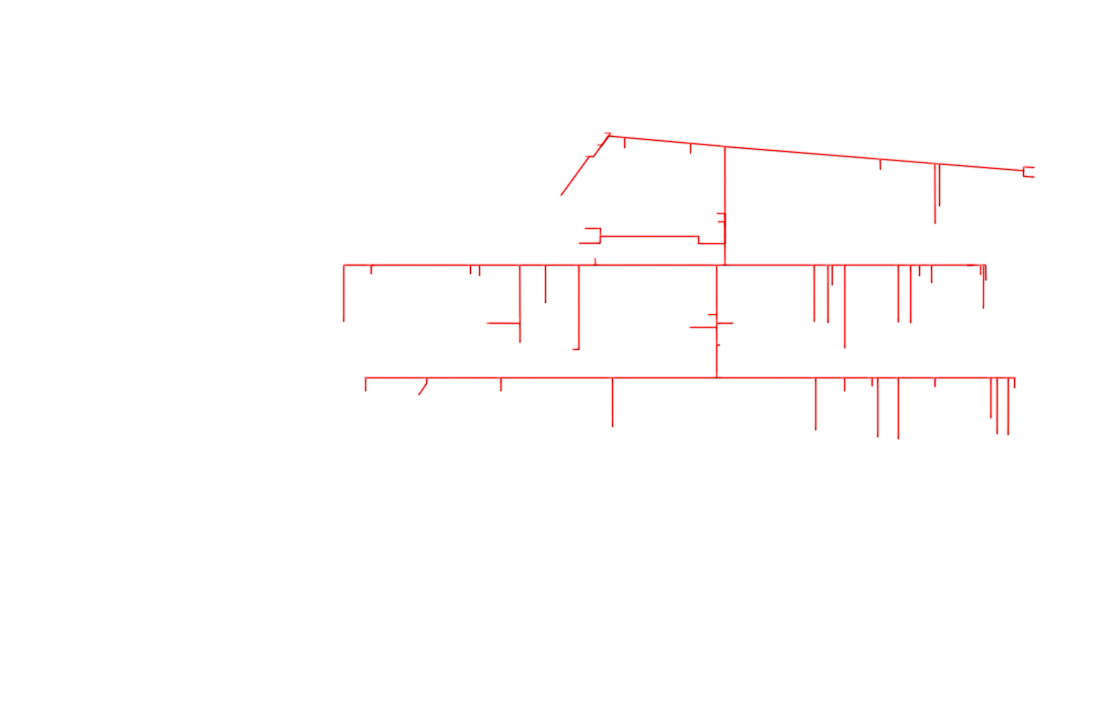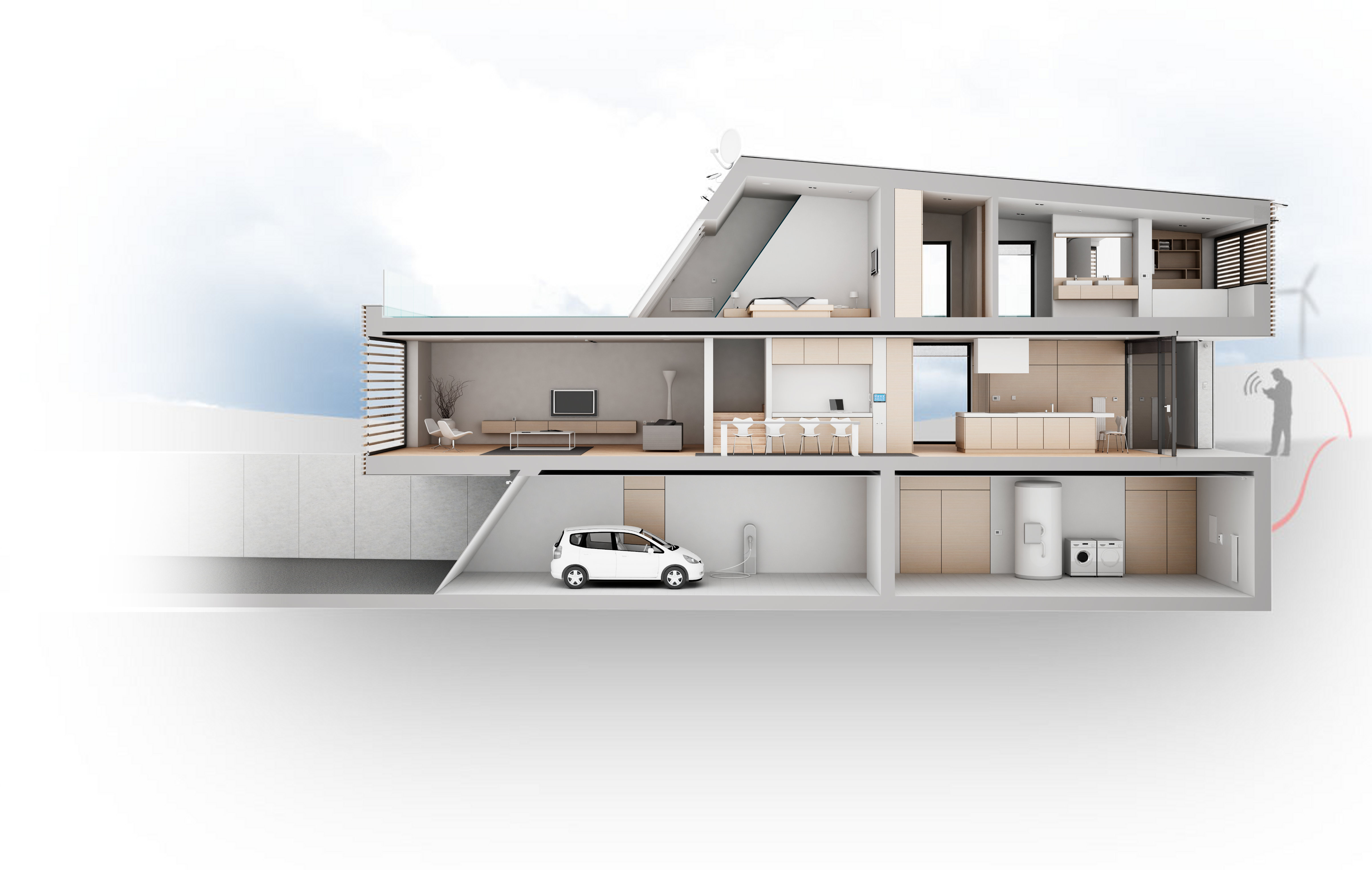
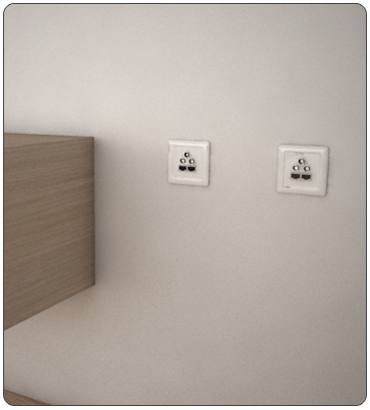
Media access:
All rooms in the “Smart House” possess an ample number of multi-media terminals. Every room can thereby be flexibly and individually equipped with a telephone, computer or modern TV set which can send or receive signals from an antenna, cable or satellite as desired. Where changes are needed – for example the children’s room – devices can be exchanged quickly and easily.

Touch panel / Home automation systems:
The touch panel is one of the central control items for regulating the networking components. The key to this is simple intuitive handling – despite the many components that are controlled through the networking home. Technique adapts to the individual needs of the user.
All networking devices within the home are easily controlled with the touch panel so one can start the washing machine without going to the basement, regulate the lights in all rooms as wished as well as control the windows, blinds and heating system.
As a basis for the intelligent networking in the home, different technologies are applicable. Widely used are so-called bus systems, for example based on the internationally recognized KNX standard. It is called bus system if the data transmission between several components functions on a common transmission. The data transmission can be done via cable or via radio.
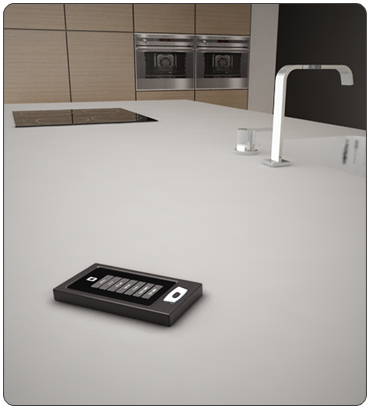
Smartphone:
A modern Smartphone offers the possibilities to control home appliances and services while underway. The oven can be started while on the way home or the heating set to a comfortable temperature.
In addition an increase in comfort, the mobile connection also cares for security: as needed, the Smartphone informs you if the windows and doors are closed or issues a warning in cases of power failure, fire, water damage or an attempted burglary.
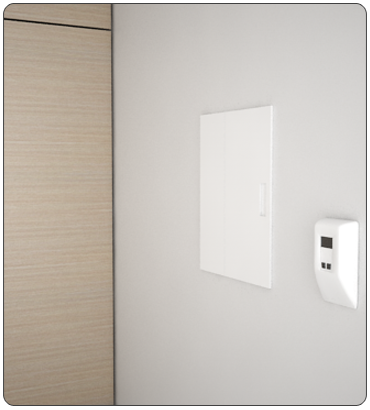
Supply connections:
The connection to the electric grid is over the trunk cable (mains). As an example, the oven will be supplied with 400-volt three-phase electric power (colloquially high voltage power).
The fiber optic cable connection (FTTH) allows a nearly loss-free transfer of the signal quality and satisfies future bandwidth requirements. Next to the classic use of the internet, it is possible to have an ultra-HD quality TV as well as video-on-demand.
In addition to bus and power connections, the connections for water and sewage among others are also located in the basement.

Solar energy systems :
The potential for energy from the sun is nearly limitless. The solar energy that reaches the earth exceeds the demand many times over. Modern solar energy systems exploit this potential to create energy (photovoltaic) and for the preparation of warm water for heating (solar thermal). Further, modern solar energy systems allow for intelligent connection to heating, home appliances, and services. This saves additional energy and costs.
For example: the solar thermal unit supports the heating pump in the basement for warming water. When the outside temperature is very low and there is little sunlight, the instantaneous water heater comes on to provide the wished water temperature, whereby with high outside temperatures the solar thermal system assumes this assignment. The interaction of the individual components occurs automatically, but comfortably allows individual regulation of the home systems at any time through the information panels, or with the use of a Smartphone while underway.
Solar panels not only create electricity for personal use – such as recharging an electric vehicle – but surplus energy can also be fed into a battery storage device or the power grid. Thus, the home becomes its own “power plant”.
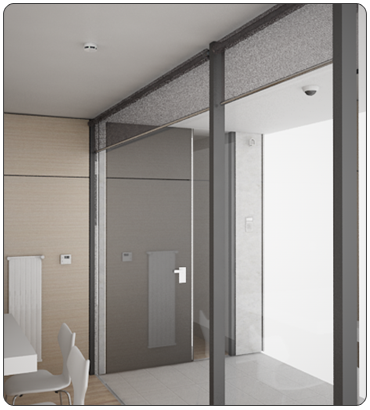
Blinds / Shutters:
Electrically controlled shutters or blinds offer additional comfort, security as well as save energy. At nightfall, they automatically shut and - in combination with light and temperature sensors – offer a comfortable level of light and temperature in the rooms during the day. Naturally, they can be individually adjusted at any time.

Blinds / Shutters:
Blinds closed continuously over many days can indicate to a burglar that the inhabitants are traveling and that a burglary is possibly free of risk. An intelligent and networked control of blinds minimizes this danger. While on vacation, the blinds are opened and closed and simulate - in combination with appropriate automatic light controls – an inhabited house.

Windows:
Windows have an extreme effect on room temperatures and air flow, in addition to being an important factor in home security. These multiple demands require modern windows to employ the help of sensors with an intelligent overlay of home technology: a small contact in the window registers whether the window is open or closed. Upon leaving the house any open window is registered, and the heating for that room will be regulated automatically. This inhibits unnecessary use of energy which in turn protects the environment.
Electronic skylights not only close automatically when it rains or storms, but can also allow ventilation if the temperature in the particular room deviates from the desired comfort range or if poor air quality is measured.

Windows:
Windows are a natural weak point when it comes to securing a house or an apartment from burglary. Here, networked burglar alarm systems can provide a remedy. A small contact in the window registers whether it is open or is closed. When leaving the house, an information display indicates whether all safety-relevant windows are properly closed. Burglaries, which were aided by accidentally opened windows, are a thing of the past. Another advantage of networking: while underway, the status of windows can be checked and controlled as required via Smartphone. Electrically operated roof windows, in conjunction with sensors, can close independently when rains or storms are detected.
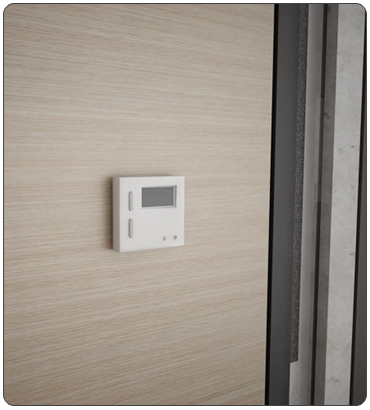
Daylight sensors:
Daylight sensors measure the brightness at specific spots in a room – e.g. at the desk – or the outside areas. With this information, the lighting can be adjusted in coordination with the general daylight. This ensures constant ideal illumination and also saves energy.

Heating:
A combined solar-heat and photovoltaic system in connection with a heat pump and an intelligent instantaneous water heater can dramatically reduce energy consumption for heat and warm water. Cost savings can be increased when the automatic, integrated windows and blinds optimize the passive use of solar energy in winter as well as shading window surfaces in summer.
Heat pumps take surrounding warmth and „pump” it up to deliver the warmth to the tap and service water. Therefore: the less the difference between the surrounding environment and the desired temperature of the room, the less the heat pump has to work. The pump uses environmental warmth derived from the surrounding air, ground water or earth as its source.

Sensor mats:
It is a great wish of elderly or health impaired people to live as long as possible within familiar surroundings. Cable-free sensor mats offer a greater sense of security to persons in danger of falling or with dementia - as well as to their relatives.
Senor mats can be used as a bed or door mat, or laid out in the bathroom. The sensors recognize if the individual is walking about or has perhaps fallen. Depending on the programming, the sensors send a signal on to the home intercom system or to the home emergency call system, thereby informing relatives or care providers – also at night - when and where a person has left their bed or room and perhaps needs help.
Sensor mats are also appropriate for outside use, such as by the main entrance, the door to the garden, on the terrace or in the yard.
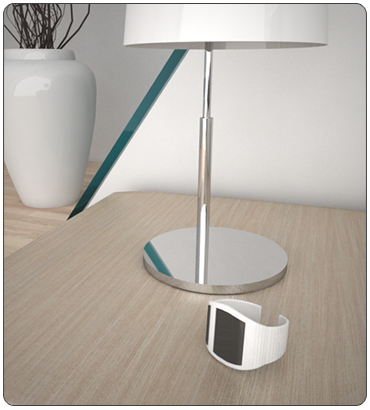
Emergency call system :
Intelligent emergency call systems offer seniors or people with health impairments additional security within their own four walls. Numerous systems are comprised of a convenient, mobile transmitter which the user wears around the neck or arm as well as a base unit connected with the telephone which can be integrated into the overall home system.
With the touch of a button on the transmitter, a signal will be sent by way of the telephone system to a previously designated person or an around the clock emergency call center. The system allows for calls to be made to several specified recipients in contrast to a system only connected to one emergency call center. The system automatically dials a preset list of telephone numbers until the call is answered, thereby assuring that the emergency call will be received. Several systems are capable of automatically providing a name and address in the case the person seeking help is unable to speak.
Home emergency systems can also help in cases where an active touch of the emergency button is not possible: sensors in the mobile transmitter register when there is no movement over a longer time – as when a person falls and lies unconscious on the floor. Smoke detectors can also be integrated into the home emergency system guaranteeing a quick response in the case of fire.
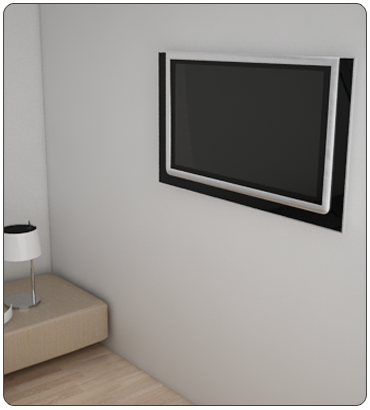
Monitor/TV:
Thanks to intelligent home technologies, the TV can offer more possibilities than simply presenting television programs. In the “Smart Home” it functions as one of the central service units over which all connected components, like blinds, lights or heating can be controlled. Even further, the TV allows monitoring of the personal health information registered by the EKG or blood pressure devices.
Furthermore, the TV set can be employed for communication purposes with a medical center. This allows patients to receive a quick feedback on their state of health from caretakers or doctors at any time.
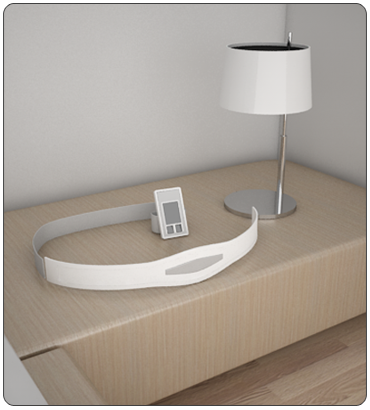
EKG chest strap :
Persons with chronic cardiovascular illness or at high risk of heart attack can independently gather information about their health at home. Modern devices are interconnected and simple to use. Gathered information can easily be reviewed on a smartphone, or even on TV, as well as regularly sent to the appropriate physician. Better acquisition of information allows both the physician and patient to react early to changes in condition and improves the quality of treatment. A further advantage for the patient of ambulatory health assessment is a reduction in the number of visits to the physician for routine check-ups.
All information can be transferred to a telemedicine center that is staffed around the clock. Life saving measures can be taken at any time in case of an emergency.
Devices to measure blood sugar (glucometers) can be similarly interconnected to offer diabetes patients additional comfort and security.
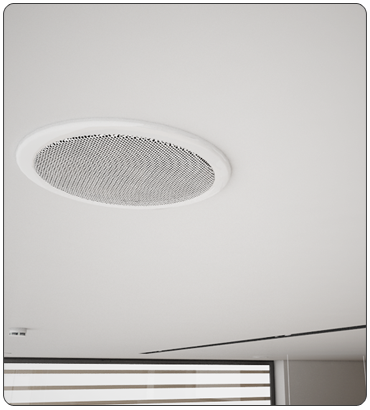
Loudspeakers:
With a networking audio system – also called a multi-room system - you can hear and control your favorite music in any room. Integrated speaker and intelligent control modules can access a central audio system from any room, which allows listening to the radio in the bathroom while another selection of your music collection simultaneously may be played in the living room or be streamed from the internet.
The audio system can be controlled with the installed control units – i.e. the touch panels of the home automation – or by remote control or Smartphone.

Loudspeakers:
With a networking audio system – also called a multi-room system - you can hear and control your favorite music in any room. Integrated speaker and intelligent control modules can access a central audio system from any room, which allows listening to the radio in the bathroom while another selection of your music collection simultaneously may be played in the living room or be streamed from the internet.
The audio system can be controlled with the installed control units – i.e. the touch panels of the home automation – or by remote control or Smartphone.
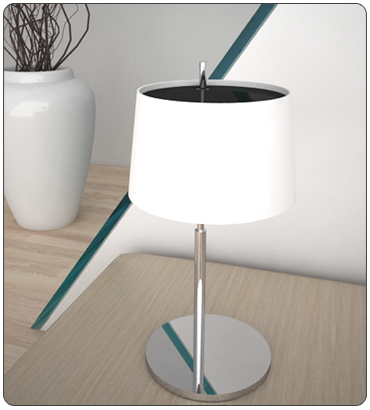
Light:
A networked control of lighting has many advantages: it helps to reduce energy costs and ensures more comfort. In addition, it increases home security. An example: individual rooms or outdoor lighting can be activated by the touch of a button - via a so-called panic button on the bed. A button like this increases the subjective feeling of security.
Lighting networked with the home automation allows switching on and off of indoor and outdoor lights to simulate a presence when no one is at home. Because most burglaries are committed when the home is not occupied, such programs increase the protection against burglars.
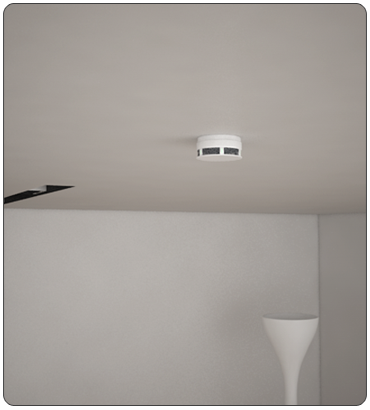
Smoke detectors :
Networked fire or smoke detectors in the home loudly warn of danger in a timely manner reducing the risk of life-threatening smoke inhalation during sleep. In the case of fire, intelligently networked skylights and windows are electrically opened to better ventilate and release life-hazardous smoke and heat. This extends the amount of time required to escape and makes it easier for rescue personnel to extinguish the fire. A network with automatic sprinkler systems, such as in the basement or in the garage, is also possible.
Smoke detectors also increase security when no one is at home. The sensors detect a fire, then trigger a warning over the Smartphone or send an alarm directly to the fire department.
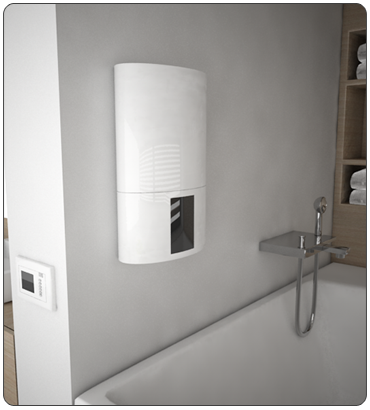
Instantaneous water heater :
Today’s modern instantaneous water heaters working efficiently in combination with a heat pump can reduce energy usage. Here the instantaneous water heater displays its strength: in the end, it only requires energy when warm water is needed. In contrast to systems with a storage tank, it does not hold a large amount of water at a constant temperature.
In combination with a heat pump, which utilizes warmth in the surrounding air or in the ground, the instantaneous water heater only activates when the temperature of the already warmed water from the heat pump is not sufficient.

Thermostat:
Thermostats individually measure the temperature in each room and automatically regulate the heat supply to the desired comfort level. The system reduces heating at night or during longer absences resulting n energy savings through simple means. The interaction between the control of the blinds and information from outside temperature and light sensors creates light and temperature levels which can be regulated individually for each room.

Scales:
The regular monitoring of one’s own body weight or percentage of body fat can provide important indications to individuals regarding their health. A scale connected with the home system offers new possibilities. The measured levels can easily be viewed on a smartphone. Changes in days, weeks or months can be seen at a glance. This information can be regularly and automatically sent to the responsible physician when a therapy is required.
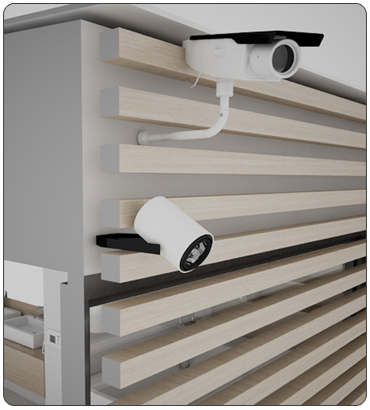
Light:
A networked control of lighting has many advantages: it helps to reduce energy costs and ensures more comfort. In addition, it increases home security. An example: individual rooms or outdoor lighting can be activated by the touch of a button - via a so-called panic button on the bed. A button like this increases the subjective feeling of security.
Lighting networked with the home automation allows switching on and off of indoor and outdoor lights to simulate a presence when no one is at home. Because most burglaries are committed when the home is not occupied, such programs increase the protection against burglars.
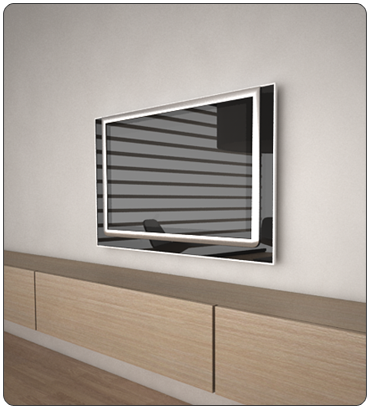
Television:
Modern televisions offer possibilities far beyond simple program viewing. Thanks to the integrated tuner, hard drives, and internet functions smart TVs provide for a wholesome digital world in the living room: classic TV programs, online choices such as video-on- demand, media libraries and HbbTV, or recent holiday pictures are at the viewer´s disposal at any time. Due to the new Ultra HD Technology and HDR imaging, this is provided to the highest picture and sound quality.
The television set does not only function as a media center but is also part of the home network: Want to comfortably check from your couch who just rang the bell? No problem, thanks to integrated technology.
Additionally, modern LED-TV sets are more energy efficient.

Television:
Modern televisions offer possibilities far beyond simple program viewing. Thanks to the integrated tuner, hard drives, and internet functions smart TVs provide for a wholesome digital world in the living room: classic TV programs, online choices such as video-on- demand, media libraries and HbbTV, or recent holiday pictures are at the viewer´s disposal at any time. Due to the new Ultra HD Technology and HDR imaging, this is provided to the highest picture and sound quality.
The television set does not only function as a media center but is also part of the home network: Want to comfortably check from your couch who just rang the bell? No problem, thanks to integrated technology.
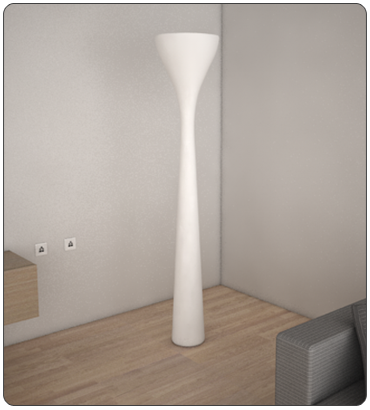
Light:
Centrally controlled lighting not only creates more comfort and security but also saves energy: just the touch of a button can create various light settings – for reading, working, celebrating or relaxing - or the lights in the entire home can be turned off. Utility rooms such as the basement or garage are only lit when in use provided they are combined with movement or presence sensors.
The interaction of blinds and artificial light sources also contain a high potential in energy savings. Intelligent sensors measure not only the light level but also the outer and inner temperatures. Blinds and lighting can be controlled as wished. In the summer the rooms stay protected from overheating while a constant level of light is maintained.
In addition, intelligent lighting assures more security. Movement sensors in the garden or at the door specifically turn on the outdoor lights when activated. This is a comfort for occupants and a deterrent to unwanted visitors. Energy efficient LED illumination on light switches, steps and staircases can help with orientation in the dark and reduce the risk of a fall.

Light:
A networked control of lighting improves home comfort. With a touch of a button, the light in a defined area of the house or apartment can be turned on and off as well as choose predefined lighting scenarios. Reading, working, partying or relaxing – for each activity the appropriate lighting is available.
Coupled motion or presence sensors illuminate adjacent rooms like the basement or the garage only when absolutely necessary.
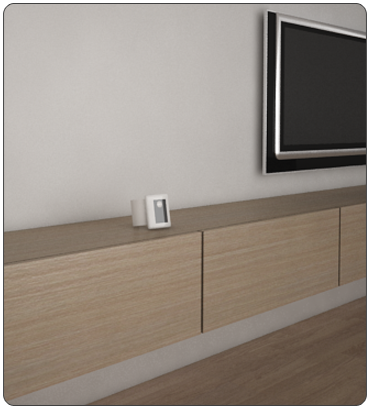
Blood pressure monitors :
Persons with chronic cardiovascular illness or at high risk of heart attack can independently gather information about their health at home. Modern devices are interconnected and simple to use. Gathered information can easily be reviewed on a smartphone, or even on TV, as well as regularly sent to the appropriate physician. Better acquisition of information allows both the physician and patient to react early to changes in condition and improves the quality of treatment. A further advantage for the patient of ambulatory health assessment is a reduction in the number of visits to the physician for routine check-ups.
All information can be transferred to a telemedicine center that is staffed around the clock. Life saving measures can be taken at any time in case of an emergency.
Devices to measure blood sugar (glucometers) can be similarly interconnected to offer diabetes patients additional comfort and security.
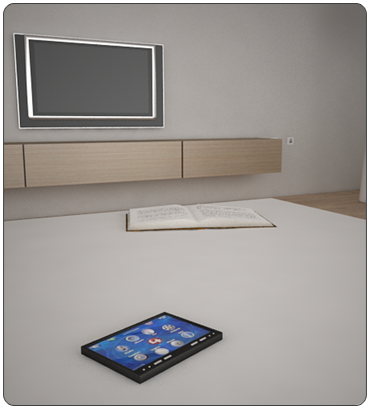
Remote control :
Smartphones and tablets are the ideal complements to built-in touch panels. All components of interconnected home technology can be easily controlled by them: light dimming, the closing of blinds, playing of movies - all comfortably performed from your sofa. Certain scenarios can be pre-programmed. So, at the touch of a button, the living room becomes a home theater or a quiet retreat with appropriate lighting and music.
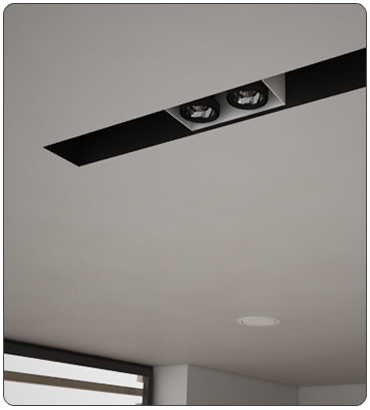
Light:
A networked control of lighting improves home comfort. With a touch of a button, the light in a defined area of the house or apartment can be turned on and off as well as choose predefined lighting scenarios. Reading, working, partying or relaxing – for each activity the appropriate lighting is available.
Coupled motion or presence sensors illuminate adjacent rooms like the basement or the garage only when absolutely necessary.

Refrigerator:
The interconnected refrigerator is equipped with cameras, which at each door closing take images of the current content. This makes it possible while being on the way, to check through the smartphone which of the groceries are stocked.
An information display at the front of the fridge provides up-to-date information about other household technologies: for example if the washing machine has already finished its cycle. And if the freezer in the basement should not have been properly closed, this would also be signaled by the fridge.
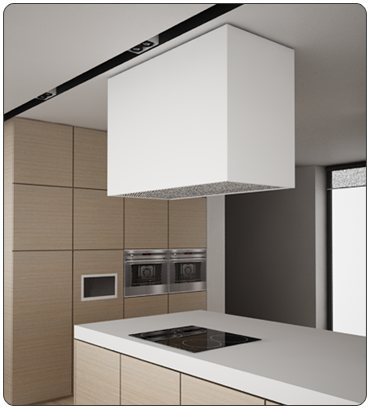
Ventilation hood :
An intelligent ventilation hood over the range automatically turns on as needed as well as chooses the appropriate power. This provides comfort, saves energy and provides a comfortable climate in the kitchen.

Outside temperature sensors :
Outside temperature sensors which are connected to home appliances and services deliver much more than simply indicating the current temperature. They deliver needed information to intelligently control ventilation, as well as open or close specific windows. Additionally, they automatically control blinds and shades on hot days. Outside temperature sensors deliver an important contribution to the home by creating a pleasant indoor climate as well as lowering energy usage.

Emergency call system :
Intelligent emergency call systems offer seniors or people with health impairments additional security within their own four walls. Numerous systems are comprised of a convenient, mobile transmitter which the user wears around the neck or arm as well as a base unit connected with the telephone which can be integrated into the overall home system.
With the touch of a button on the transmitter, a signal will be sent by way of the telephone system to a previously designated person or an around the clock emergency call center. The system allows for calls to be made to several specified recipients in contrast to a system only connected to one emergency call center. The system automatically dials a preset list of telephone numbers until the call is answered, thereby assuring that the emergency call will be received. Several systems are capable of automatically providing a name and address in the case the person seeking help is unable to speak.
Home emergency systems can also help in cases where an active touch of the emergency button is not possible: sensors in the mobile transmitter register when there is no movement over a longer time – as when a person falls and lies unconscious on the floor. Smoke detectors can also be integrated into the home emergency system guaranteeing a quick response in the case of fire.

PC/Laptop:
The computer as a comfortable control unit: in the networked home, for example, blinds, lighting or even the room temperature can be controlled via the PC or the laptop. The internet is accessed by connection to the high-speed broadband network.

Touch panel / Home automation systems:
The touch panel is one of the central control items for regulating the networking components. The key to this is simple intuitive handling – despite the many components that are controlled through the networking home. Technique adapts to the individual needs of the user.
All networking devices within the home are easily controlled with the touch panel so one can start the washing machine without going to the basement, regulate the lights in all rooms as wished as well as control the windows, blinds and heating system.
As a basis for the intelligent networking in the home, different technologies are applicable. Widely used are so-called bus systems, for example based on the internationally recognized KNX standard. It is called bus system if the data transmission between several components functions on a common transmission. The data transmission can be done via cable or via radio.

Touch panel / Home automation systems:
The touch panel is one of the central control items for regulating the networking components. The key to this is simple intuitive handling – despite the many components that are controlled through the networking home. Technique adapts to the individual needs of the user.
All networking devices within the home are easily controlled with the touch panel so one can start the washing machine without going to the basement, regulate the lights in all rooms as wished as well as control the windows, blinds and heating system.
As a basis for the intelligent networking in the home, different technologies are applicable. Widely used are so-called bus systems, for example based on the internationally recognized KNX standard. It is called bus system if the data transmission between several components functions on a common transmission. The data transmission can be done via cable or via radio.

Smartphone:
Smartphones are personal digital everyday companions. They expand their potential by being integrated into the interconnected home. All connected components can be mobile controlled: the oven can be preheated or the temperature in a given room set to the desired comfort level while on the way home. With the Smartphone you have the possibilities of networked home automation in hand in the truest sense of the word.

Smartphone:
Controlling home automation on the go? This is easily possible with a Smartphone. For example, it can let you know if windows and doors are closed. With the occurrence of unusual events such as power failure, fire, water damage or a burglary attempt, it sends a specific warning enabling a quick response.

Access control system :
A modern, networked access control system ensures safety in the House: register sensors on the doors register if the doors are properly closed and locked. An integrated video camera at the entrance serves as an access control system. A touch panel, smartphone or TV set shows who is may be waiting at the door. Of course, a door using these control units can also be opened without leaving your current location.
The locking system can be also equipped with a combined code and fingerprint reader. The finger becomes a personal key, which can neither be lost nor forgotten.
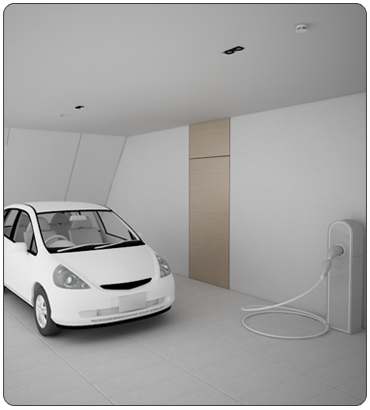
Electric vehicle charging station :
The interconnected home provides an intelligent charging station so electric cars can recharge both economically and ecologically. The Smart Meter (intelligent electric meter) shows when it is economical to re-charge, such as when there is an abundance of available wind or solar energy, whereby it is possible to set individual parameters such as minimum re-charging or maximum electric price.
Stored energy serves both as an “emergency reserve” or can be fed into the grid during peak service. Prerequisite is an intelligent power grid infrastructure (Smart Grid), to be built parallel with the developments in electromobility.
Solar panels on one’s roof also provide inexpensive power to the “filling station”. Energy will be produced in one’s own home and can be used for e-mobility.

Motion sensor:
Motion and presence sensors control lighting inside and outside the apartment or house automatically and as needed according to personal specifications. Lights controlled by the sensors show the way - for example, from the garage to the front door. At the same time, lighting controlled by motion sensors deters unwanted visitors and ensure additional safety.

Heat pump:
A combined solar-heat and photovoltaic system in connection with a heat pump and an intelligent instantaneous water heater can dramatically reduce energy consumption for heat and warm water. Cost savings can be increased when the automatic, integrated windows and blinds optimize the passive use of solar energy in winter as well as shading window surfaces in summer.
Heat pumps take surrounding warmth and „pump” it up to deliver the warmth to the tap and service water. Therefore: the less the difference between the surrounding environment and the desired temperature of the room, the less the heat pump has to work. The pump uses environmental warmth derived from the surrounding air, ground water or earth as its source.
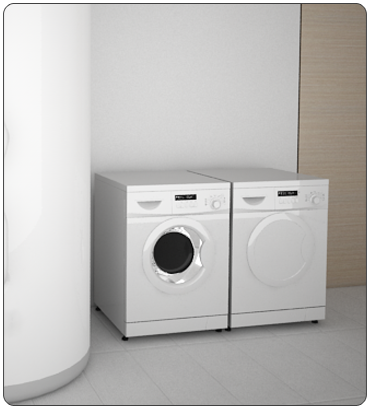
Dryer/Washing machine:
Modern washing machines and dryers require much less electricity and water than before. They will increasingly be integrated into intelligent home technology. Thanks to their communication modules, they can be operated by control panels at home as well as by a smartphone or tablet on the go. This allows their status or remaining running time to be checked at any time.
In connection with the intelligent electric meter (Smart Meter), the washing machine or dryer automatically turns itself on when the energy provider offers a lower price.

Smart Meter:
Smart meters are intelligent electricity meters that not only measure usage but are also able to exactly display the momentary performance. An analysis of the information is also possible through the internet. Smart Meters enable complete transparency, identify “guzzler” and offer new opportunities for saving energy and lowering costs.
The smart meter is an important element in the interaction of intelligent home technologies. It can deliver information about self-produced energy (like solar panels on the roof) and about energy needs. This provides the basis for a need-based, cost efficient management of home appliances and services – such as running the dishwasher when cheaper energy is available.

Motion detector :
Motion and presence sensors control lighting inside and outside the apartment or house according to individual specifications. Sensor-controlled light points the way: you don´t have to enter the basement, garage or laundry room in the dark any longer.
Networking:
Home automation, entertainment and consumer electronics: what once operated parallel, home networking joins together. That and a unified system control are a requirement for improved energy efficiency, a healthy environment, comfort and security in an apartment or house. Two examples:
Within a “Smart Home” sensors oversee if the windows are opened or closed and report this information to the heating system. If the windows are open for airing then the heat to the heating units is stopped or reduced in order to save energy.
Intelligent power meters (Smart Meters) constantly report the current energy usage, thereby controlling consumption and identifying areas of energy inefficiency. Also when travelling, one can check if the energy usage has been appropriately reduced while away. If this is not the case, then the devices can be controlled or shut down by use of a mobile telephone.
Thanks to innovative transmission technology – for example via satellite, antenna or cable – home networking will be possible. You can discover the further advantages of “Smart Home” technologies in the individual home areas of your choice: examples of usage show how the network functions in daily use and what your benefits are.Energy efficiency:
Intelligent technologies and networked components help to provide efficient household energy usage. Through the interconnection of lighting, heating, solar devices, shades and windows, various room requirements can be individualized to conform to the time of day, and if desired, either controlled automatically through sensors which recognize your presence in the rooms or through a smartphone. This reduces energy costs and raises living comfort.
A large energy and savings potential is offered by the visualization of energy consumption through the help of an intelligent power meter - the Smart Meter. This device reports real- time energy use and stores the consumption figures. This creates transparency in helping to better judge needs.
Through choosing the rooms, discover which currently available technologies can reduce the energy needs of your apartment or house.
Health:
Demographic developments show that the percentage of people over 65 in Germany is rapidly increasing. The private apartment or private house will, therefore, play an increasingly important role in health care. Under the name of “Ambient Assisted Living” (AAL), technical support systems are combined to help people live longer and independently in their accustomed surroundings. Additionally, new medical services provide continued care at home - by telemedicine for example.
Modern blood pressure devices, sensor mats or emergency paging systems: within a “Smart Home” numerous connected devices provide a clear improvement in comfort and security. You can discover more in the individual rooms.
Comfort and Entertainment:
Home networking is not an end in itself but serves numerous ways to increase living comfort. As an example: while away it is possible to control the temperature in individual rooms by mobile telephone. Apartments and houses, uncomfortably cold after a longer absence, are now a thing of the past.
In the home itself, permanently installed or mobile controls allow many components to be operated both centrally and comfortably. With one look while in the bedroom, one can even tell if all windows and doors are closed and all the lights are off in the other rooms.
The control of lighting is another component of home comfort: whether while reading, watching TV, working or relaxing – for every activity, there are individually defined lighting programs at your disposal. A push of a button creates the appropriate atmosphere. Sensors also recognize if someone is in the room and if the correct light source should be turned on or off.
Security:
The private four walls are an important retreat. Feeling secure at home is an important aspect of quality of life. The interaction of networking elements within the apartment or house significantly raises security. Sensors on doors and windows register if they are closed and report unauthorized openings. Smoke detectors emit an immediate alarm in case of fire. Provided you are connected to an emergency system, the fire department also receives a signal to come to your assistance as quickly as possible.
Burglaries most often occur when it seems no one is at home, making it important to signal a presence. Here, modern systems intermittently turn lights on and off, or raise blinds during the day and close them at night.
You will find more details about intelligent security systems in the individual rooms.
Electromobility:
Electromobility is considered as a key technology of the 21st Century. An increasing number of car manufacturers have been offering e-mobility. The Federal Government of Germany aims towards electromobility as well. By 2020 there should be at least one million electric vehicles underway on German streets.
Electromobility is, however, more than simply an electric engine in an auto. It will first be truly attractive in symbiosis with an intelligent energy infrastructure (Smart Grid). Batteries for electric vehicles can act as energy reservoirs that tap the expanding choice of fluctuating energy sources - such as the wind and solar energy - or the networked house with its own solar re-charging station.






